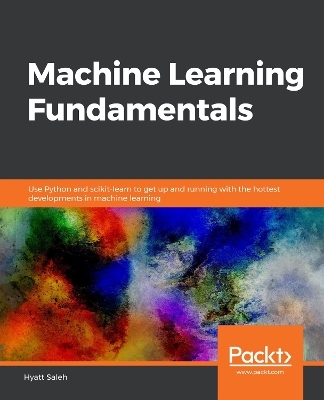
Machine Learning Fundamentals
Use Python and scikit-learn to get up and running with the hottest developments in machine learning
Seiten
2018
Packt Publishing Limited (Verlag)
978-1-78980-355-6 (ISBN)
Packt Publishing Limited (Verlag)
978-1-78980-355-6 (ISBN)
As machine learning algorithms become popular, new tools that optimize these algorithms are also developed. Machine Learning Fundamentals explains the scikit-learn API, which is a package created to facilitate the process of building machine learning applications. By explaining the differences between supervised and unsupervised models and by ...
With the flexibility and features of scikit-learn and Python, build machine learning algorithms that optimize the programming process and take application performance to a whole new level
Key Features
Explore scikit-learn uniform API and its application into any type of model
Understand the difference between supervised and unsupervised models
Learn the usage of machine learning through real-world examples
Book DescriptionAs machine learning algorithms become popular, new tools that optimize these algorithms are also developed. Machine Learning Fundamentals explains you how to use the syntax of scikit-learn. You'll study the difference between supervised and unsupervised models, as well as the importance of choosing the appropriate algorithm for each dataset. You'll apply unsupervised clustering algorithms over real-world datasets, to discover patterns and profiles, and explore the process to solve an unsupervised machine learning problem.
The focus of the book then shifts to supervised learning algorithms. You'll learn to implement different supervised algorithms and develop neural network structures using the scikit-learn package. You'll also learn how to perform coherent result analysis to improve the performance of the algorithm by tuning hyperparameters.
By the end of this book, you will have gain all the skills required to start programming machine learning algorithms.
What you will learn
Understand the importance of data representation
Gain insights into the differences between supervised and unsupervised models
Explore data using the Matplotlib library
Study popular algorithms, such as k-means, Mean-Shift, and DBSCAN
Measure model performance through different metrics
Implement a confusion matrix using scikit-learn
Study popular algorithms, such as Naïve-Bayes, Decision Tree, and SVM
Perform error analysis to improve the performance of the model
Learn to build a comprehensive machine learning program
Who this book is forMachine Learning Fundamentals is designed for developers who are new to the field of machine learning and want to learn how to use the scikit-learn library to develop machine learning algorithms. You must have some knowledge and experience in Python programming, but you do not need any prior knowledge of scikit-learn or machine learning algorithms.
With the flexibility and features of scikit-learn and Python, build machine learning algorithms that optimize the programming process and take application performance to a whole new level
Key Features
Explore scikit-learn uniform API and its application into any type of model
Understand the difference between supervised and unsupervised models
Learn the usage of machine learning through real-world examples
Book DescriptionAs machine learning algorithms become popular, new tools that optimize these algorithms are also developed. Machine Learning Fundamentals explains you how to use the syntax of scikit-learn. You'll study the difference between supervised and unsupervised models, as well as the importance of choosing the appropriate algorithm for each dataset. You'll apply unsupervised clustering algorithms over real-world datasets, to discover patterns and profiles, and explore the process to solve an unsupervised machine learning problem.
The focus of the book then shifts to supervised learning algorithms. You'll learn to implement different supervised algorithms and develop neural network structures using the scikit-learn package. You'll also learn how to perform coherent result analysis to improve the performance of the algorithm by tuning hyperparameters.
By the end of this book, you will have gain all the skills required to start programming machine learning algorithms.
What you will learn
Understand the importance of data representation
Gain insights into the differences between supervised and unsupervised models
Explore data using the Matplotlib library
Study popular algorithms, such as k-means, Mean-Shift, and DBSCAN
Measure model performance through different metrics
Implement a confusion matrix using scikit-learn
Study popular algorithms, such as Naïve-Bayes, Decision Tree, and SVM
Perform error analysis to improve the performance of the model
Learn to build a comprehensive machine learning program
Who this book is forMachine Learning Fundamentals is designed for developers who are new to the field of machine learning and want to learn how to use the scikit-learn library to develop machine learning algorithms. You must have some knowledge and experience in Python programming, but you do not need any prior knowledge of scikit-learn or machine learning algorithms.
After graduating from college as a business administrator, Hyatt Saleh discovered the importance of data analysis for understanding and solving real-life problems. Since then, as a self-taught person, she has not only worked as a freelancer for many companies around the world in the field of machine learning, but also founded an artificial intelligence company that aims to optimize everyday processes.
Table of Contents
Introduction to sciki-learn
Unsupervised Learning: Real-life Applications
Supervised Learning: Key Steps
Supervised Learning Algorithms: Predict Annual Income
Artificial Neural Networks: Predict of Annual Income
Building Your Own Program
| Erscheinungsdatum | 06.12.2018 |
|---|---|
| Verlagsort | Birmingham |
| Sprache | englisch |
| Maße | 75 x 93 mm |
| Themenwelt | Mathematik / Informatik ► Informatik ► Programmiersprachen / -werkzeuge |
| Informatik ► Theorie / Studium ► Algorithmen | |
| Informatik ► Theorie / Studium ► Künstliche Intelligenz / Robotik | |
| ISBN-10 | 1-78980-355-1 / 1789803551 |
| ISBN-13 | 978-1-78980-355-6 / 9781789803556 |
| Zustand | Neuware |
| Haben Sie eine Frage zum Produkt? |
Mehr entdecken
aus dem Bereich
aus dem Bereich
IT zum Anfassen für alle von 9 bis 99 – vom Navi bis Social Media
Buch | Softcover (2021)
Springer (Verlag)
CHF 41,95
Interlingua zur Gewährleistung semantischer Interoperabilität in der …
Buch | Softcover (2023)
Springer Fachmedien (Verlag)
CHF 46,15
Eine Einführung mit Java
Buch | Hardcover (2020)
dpunkt (Verlag)
CHF 62,85


